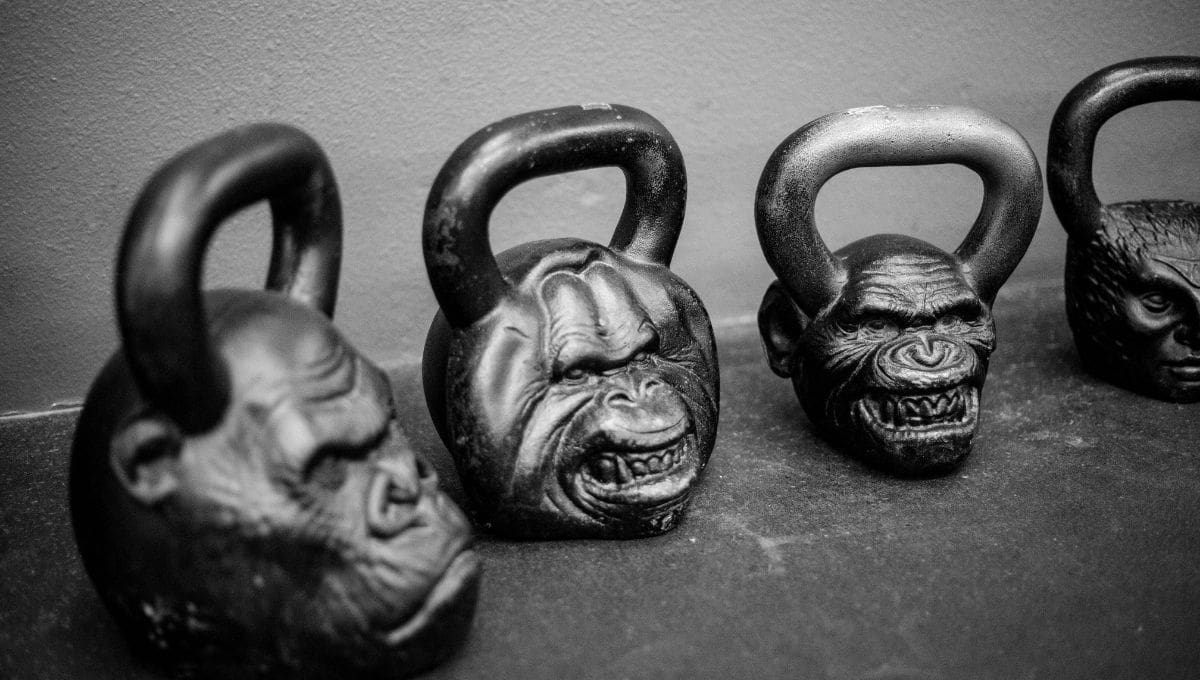This complete guide will teach you everything you need to know about the Kettlebell Windmill.
What is the Kettlebell Windmill?
The kettlebell windmill is an excellent exercise for the shoulders, abs, and obliques. It’s also a strong dynamic stretch for the hamstrings and adductors.
 Source: Courtesy of CrossFit Inc.
Source: Courtesy of CrossFit Inc.While it is not one of the more well-known kettlebell moves, it remains a valuable exercise in any well-rounded workout routine. In this guide, we’re going to cover how to perform a kettlebell windmill safely and effectively so that you can start using them on your own.
It is a great exercise for conditioning, strength, and flexibility.
- What is the Kettlebell Windmill?
- How to Perform a Kettlebell Windmill
- What Muscles Does the Kettlebell Windmill Work?
- Kettlebell Windmill Benefits
- Technique Tips for the Kettlebell Windmill Exercise
- Common Variations of the Kettlebell Windmill
- How to Make the Kettlebell Windmill Harder
- How to Make the Kettlebell Windmill Easier
- Common Kettlebell Windmill Mistakes
- How to Use Proper Form in a Kettlebell Windmill
- Tips for Performing Kettlebell Windmills Safely
- Conclusion
The kettlebell windmill is an advanced exercise because it requires a lot of strength and control to do correctly. However, there are ways to make this very challenging move easier if you’re not ready for the full version yet.
How to Perform a Kettlebell Windmill
The following instructions from StrongFirst are excellent. Follow them to complete the exercise safely and effectively.
Stance
- “Feet inside of shoulder width (a wide stance prevents the “shift”—more on that in a moment)
- Feet angled 45 degrees away from the arm holding the kettlebell overhead
- This is a starting point and can be adjusted to fit the individual
- Do not step or shuffle the feet—angle the feet by turning on the heel or ball of the foot respectively”
Execution
“Begin with the “shift and lift.” Shift the hip that is under the kettlebell back at a 45-degree angle to get the leg vertical and then focus on lifting that hip and making the leg as tall and long as possible while the front leg is “soft” with a bent knee. The rear heel should not rise as you try to make the leg tall. Picture a 70/30 weight distribution with 70% on the back leg and 30% on the front.”
Technique
“Another visual is to picture the “triangle” of your legs going from Figure 1—a symmetrical stance with feet angled 45 degrees away from the rear leg—to Figure 2—the rear leg is shifted to be vertical and lifted tall while the front leg is slightly bent and forms the front of the triangle.”
“The upper body should extend in a straight line off the hips and if the emphasis is on the “shift and lift” with the hip at the 45-degree angle, then the upper body will fall into that 45-degree channel. The t-spine will rotate so the arm holding the kettlebell (or reaching for the sky in the low windmill) is vertical.”
“There is to be no lateral flexion of the spine or stress on the lumbar spine.”
“The “free arm” can either reach for the ground (although touching the ground is not the goal) or provide a guide by riding down the inside of the front leg. Another position for the free arm is to place it behind the back. This will put more emphasis on opening the chest and t-spine.”
“How deeply you go into the windmill position will be determined by your “mobility ability.” You should not laterally flex the spine or change the positions to go deeper than is appropriate. Build the depth over several repetitions and practice of the drill.”
“The weight distribution should stay consistent. Once you set the 70/30 (rear to front) distribution during the shift, it should remain there for the duration of the repetition. Do not let the weight shift to the front foot in order to feel like you are going deeper.”
What Muscles Does the Kettlebell Windmill Work?
The kettlebell windmill works the core, shoulders, arms and glutes.
It’s a total-body exercise that challenges your stability and strength by engaging your core to keep you stable throughout the movement. The movement also strengthens your glutes since they are considered “the powerhouse of the body” because they provide power to the different leg movements.
Kettlebell Windmill Benefits
The kettlebell windmill is one of those exercises that has so many benefits that it should be included in everyone’s workout routine.
Here are just a few:
- Increases muscular endurance
- Increases cardiovascular endurance
- Increases core strength and stability of the core region
- Improves balance, coordination and flexibility
- Strengthens the joints and ligaments
Technique Tips for the Kettlebell Windmill Exercise
The kettlebell windmill is an advanced exercise that requires a lot of coordination, strength and endurance. In order to execute the movement properly, there are several technique tips you should keep in mind:
Keep your Chest Up and Shoulders Back
This will help you maintain proper form as you perform each repetition of the exercise by ensuring that your body is aligned correctly.
It’s also important to keep this position throughout each repetition so that you don’t compensate for poor posture by bending at the waist or rounding out your back excessively.
Keep your Core Tight at all Times
This will help prevent injury and improve overall stability in this challenging movement pattern because it creates better support for many of your joints while also providing more feedback about how they’re moving so that they can be adjusted on-the-fly if necessary
Common Variations of the Kettlebell Windmill
There are many variations of the windmill that you can use to progress and build up your strength. Some of these include:
- One-arm windmill
- Plate balance windmill
- D ball windmill
How to Make the Kettlebell Windmill Harder
There are many ways to make the kettlebell windmill harder, and you can tailor your workouts to your goals. Some options include:
- Adding weight (and adding repetitions if you choose).
- Adding sets (and adding repetitions if you choose).
- Adding time (and adding repetitions if you choose). For example, rather than doing a five minute work period and then resting for two minutes every time, try doing 10-15 minute work periods with only 30 seconds of rest between them. If desired, spread these longer workouts over several days or weeks instead of trying to do an hour all at once in one session!
- Pausing briefly between reps—this will help improve your control and increase muscle endurance by forcing the muscles that lift and lower a kettlebell apply force throughout the entire range of motion rather than just at its beginning or end points!
How to Make the Kettlebell Windmill Easier
If you’re having trouble with this movement, there are a few ways to make it easier.
Decrease the Weight of the Kettlebell
This may seem obvious, but if you’re struggling with this movement, it’s likely because you’re using too much weight and not enough technique.
Dropping your kettlebell down to a lighter weight will help force you to use more control in your movements and focus on form rather than just brute strength.
Switch your Grip on the Kettlebell
Experimenting with your grip position can help improve technique and help you find the most comfortable position for your anatomy.
Common Kettlebell Windmill Mistakes
- Don’t let the kettlebell go behind your head
- Don’t let the kettlebell go straight down
- Don’t let the kettlebell go behind your back
- Don’t let the kettlebell go below your waist
How to Use Proper Form in a Kettlebell Windmill
Let’s go through each step so you can get a feel for how to use proper form in a kettlebell windmill.
- Keep your back straight.
- Keep your arms straight.
- Keep your eyes on the kettlebell at all times.
- Your feet should always be in line with your shoulders, not out at an angle or behind you (this is bad for the lower back).
- Do not let your hips drop down too far—you may need to bend over slightly as you come around into position, but keeping them raised will help prevent injury and give more support to the lower back when performing the move.
- Do not let knees bend past 90 degrees—this is uncomfortable and can cause knee injuries if done consistently over time.
Tips for Performing Kettlebell Windmills Safely
Before attempting any kettlebell windmill, ensure you are using a weight that is appropriate for your fitness level, ability to perform the exercise safely and with proper form. A common mistake is choosing too heavy of a kettlebell and not being able to complete the movement properly.
Try this tip: Practice with a light kettlebell first (or just one arm) until you can perform it safely and confidently before adding more weight.
Conclusion
Dangerous mistakes can happen if you’re not careful, so make sure to follow these tips to get the most out of your workout.
Now that you know what a kettlebell windmill is and how it benefits your body, go ahead and give it a try!
Image Sources
- fraser kettlebell FIBONACCI: Courtesy of CrossFit Inc.
